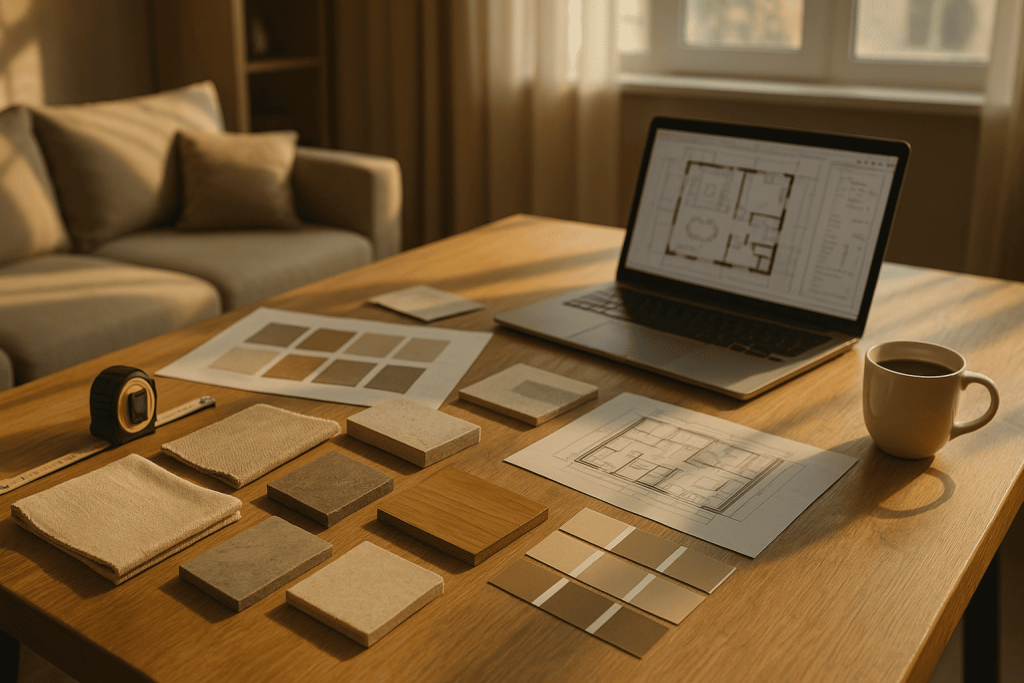Artificial intelligence can accelerate interior design from weeks to days, but speed without taste produces sterile rooms. The goal is not to let AI decide, but to direct it with a designer’s judgment so outputs reflect a coherent aesthetic, authentic materials, and the client’s lived reality. This playbook shows how to use AI as a precision power tool while protecting style, authorship, and design ethics.
Principle: AI executes, the designer decides
Great interiors come from choices about proportion, light, and life patterns, not from infinite mood boards. Treat AI as a fast assistant for exploration and documentation, while you retain control of intent, constraints, and acceptance criteria. If a choice affects safety, structure, or long-term maintenance, your decision sits above the model’s suggestion.
Define your Style DNA before you generate
Create a compact style bible that fits on one page: favored palettes, natural vs. synthetic materials, finish gloss levels, texture balance, negative space ratio, hardware profiles, and three forbidden clichés. Include two reference rooms that feel like your work. Feed this DNA into every prompt so the system reproduces a signature, not a trend.
Write briefs that read like design contracts
Translate the client’s story into non-negotiables: daylight orientation, circulation patterns, storage needs, acoustic goals, cleaning and durability requirements, and budget tiers. Add practical tolerances like maximum cabinet depth, countertop overhang, and rug clearances. Bind AI to these constraints so variations remain buildable.
Start with space, not style
Ask AI to block out functions and flow with scaled furniture footprints before it touches color. Sequence entry, prep, cooking, serving, and cleanup zones; check sight lines; test door swing conflicts; and verify ADA clearances where relevant. Only after the plan works should the palette enter the conversation.
Material realism over mood-board fantasy
Ground proposals in real SKUs and assemblies: plank widths and wood species, stone thickness and edge profiles, grout joint sizes, upholstery rub counts, and flame ratings. If a generated option lacks these specifics, instruct the assistant to label it as conceptual and propose catalog matches you can actually procure.
Light is the design; fixtures are the punctuation
Drive the model with daylight analysis and lumens-per-zone targets before it selects pendants and trims. Specify color temperature strategy, dimming curves, beam spreads, and glare control. Keep ambient, task, and accent layers distinct and let AI propose fixture schedules that you refine, not the other way around.
Color that survives real life
Constrain palettes with measured light reflectance values and metamerism notes. Tell AI to propose three palette families with paint codes, fabric references, and wood sample pairings that won’t clash under warm evening light. Require a maintenance note for each selection so beauty doesn’t depend on museum behavior.
Texture, rhythm, and the rule of quiet walls
Texture establishes depth at any budget. Instruct AI to vary sheen and grain rather than stacking patterns. Anchor one plane as visually quiet to carry the room, then distribute texture to touch points and sight lines. When the model over-decorates, prune without mercy.
Furniture that fits human movement
Make every layout defend itself with clearance callouts for knees, hips, and shoulders. Ask AI to annotate dimensions around tables, sofas, island stools, and bedside paths. If a render looks beautiful but fails a 90-second ergonomic audit, it’s a no.
Storage as choreography, not afterthought
Describe daily rituals and instruct the assistant to propose built-ins that match those sequences, from drop zones to laundry sorting to pet care niches. Label each cabinet by function and cleaning approach. Clutter solved is beauty earned.
Acoustics are part of comfort
Have the model estimate absorption needs by room use and propose soft surfaces and treatments sized to the volume, not just aesthetics. Ask for a plan that reduces reverberation times and isolates noise between zones without turning your home into a studio.
Ask for multiple good answers, then edit
Generate three distinct design directions with clear names and narratives. Iterate one step at a time—plan, material, lighting, then styling—so you can mix and match parts. Curate like an editor; you are building a story, not a poll.
Protect authorship with a recognizable through-line
Repeat a small set of signature moves across projects: a consistent cabinet rail profile, a go-to metal finish pairing, a preferred grout line, or a specific proportion in shelving reveals. Teach these to the model so your work remains identifiably yours, even when styles shift.
Ethics: credit, consent, and honesty
Disclose when images are AI-assisted, credit any artist references used to train your look, and avoid cloning someone else’s space. If the client asks for a trademarked design element, propose legal and tasteful alternatives rather than imitations.
Budget with eyes open
Force every proposal to come with a low/medium/high cost breakdown and a swap list for savings that preserve intent. The assistant can produce vendor alternates, but you approve substitutions. Beauty that survives value engineering is real design.
Local codes and common-sense safety
Constrain kitchens and baths with venting, electrical circuits, GFCI, fire clearances, and egress rules. Tell AI to flag risky placements rather than pretending everything fits. A room that passes inspection the first time protects client trust and your schedule.
Documentation your contractor will thank you for
Convert final decisions into annotated plans, elevations, finish schedules, and a punch-list. Ask AI for spec sheets and cut sheets organized by room and trade. The clearer the package, the fewer “just checking” calls you’ll take.
Client collaboration that feels human
Replace giant decks with a one-page narrative and three image pairs per decision. Add a five-sentence rationale and one alternative. Let AI produce drafts, but deliver in your voice and be present for choices that carry real consequences.
Small-space strategies that don’t feel compromised
Instruct the assistant to rotate sleeping, working, and entertaining modes with furniture that truly reconfigures. Optimize storage bays to ceiling height, hide desks behind pocket doors, and select textiles that absorb noise in multipurpose rooms.
Sustainability that reads as comfort
Favor durable, repairable materials and low-VOC finishes. Ask for embodied-carbon notes and end-of-life paths. Design for daylight first, then supplement with efficient, warm electric layers. A healthy home looks good because it feels good.
Staging without lying
Keep décor honest to daily life. Limit props to what the client will actually use. If an image requires impossible sunlight, note it as conceptual. Trust arrives when photos match move-in reality.
When AI should not lead
Do not delegate structural moves, life-safety clearances, or anything that alters building systems without professional review. Keep rare materials and heritage elements under your direct curation. Use the model to test ideas; use your expertise to protect the home.
Prompts that keep you in charge
Direct the assistant with verbs that demand reasoning: justify, compare, constrain, annotate, and specify. Ask for differences between options and require each to state a maintenance implication. The more the model explains, the better your decisions.
Quality control before you sign off
Run a final checklist for daylight balance, sight lines, ergonomic clearances, code flags, vendor lead times, and cleaning logic. If two elements fight for attention, demote one. If a surface can’t survive the household, make a smarter choice.
Conclusion
AI can widen the palette, but only taste turns options into home. Protect your authorship with a clear Style DNA, bind generation to real constraints, and demand specifics that survive sunlight, spills, and schedules. When the model works under your guardrails, you gain speed without losing soul—and the spaces you deliver will look like they belong to people, not to a prompt.



AI is powerful, but without taste and constraints it just makes pretty nonsense. This nails how to keep the soul while using the speed ☝️